HIV gp120 inhibits the somatotropic axis: a possible GH-releasing hormone receptor mechanism for the pathogenesis of AIDS wasting
- PMID: 9465119
- PMCID: PMC19215
- DOI: 10.1073/pnas.95.4.1927
HIV gp120 inhibits the somatotropic axis: a possible GH-releasing hormone receptor mechanism for the pathogenesis of AIDS wasting
Abstract
AIDS is often associated with growth retardation in children and wasting in adults. The dissociated envelope protein of the HIV (HIV-1), gp120, can be found in significant concentrations in the parenchyma and cerebrospinal fluid of brains in infected individuals, even in the earliest stages of HIV-1 disease. On the basis of this and the fact that we observed pentapeptide sequence homology between GH-releasing hormone (GHRH) and the V2 receptor-binding region of gp120, we initiated experiments to determine whether gp120 could affect GH secretion and growth in vivo and/or interact with anterior pituitary GHRH receptors in vitro. Although acute IV administration of gp120 in conscious rats had no effect on plasma GH levels, acute administration of gp120 (400 ng) into the brain significantly suppressed pulsatile GH release over a 6-h period compared with saline-injected controls. Furthermore, the putative gp120 antagonist, Peptide T (DAPTA), prevented the suppression of GH by gp120. In support of these in vivo findings, gp120 also significantly (P < 0.05) suppressed GHRH-stimulated GH release in static cultures of dispersed pituitary cells and from cells undergoing perifusion with the peptides. DAPTA prevented the GH suppression by gp120 in both of the pituitary cell paradigms. Furthermore, chronic administration of gp120 into the third ventricle significantly reduced body weight in juvenile rats, compared with saline-injected controls. Thus, gp120 appears to act both at the hypothalamus and pituitary to suppress GH release, and its action at these two locations is associated with a significant loss in body weight in chronically treated young animals. These findings may suggest a specific mechanism for the pathogenesis of wasting in HIV-1 patients that involves blockade of endogenous GHRH receptors by gp120.
Figures




Similar articles
-
Effects of acute and chronic administration of a new potent antagonist of growth hormone-releasing hormone in rats: mechanisms of action.Endocrinology. 1996 Dec;137(12):5364-9. doi: 10.1210/endo.137.12.8940358. Endocrinology. 1996. PMID: 8940358
-
Blockade of growth hormone-releasing factor (GRF) activity in the pituitary and hypothalamus of the conscious rat with a peptidic GRF antagonist.Endocrinology. 1989 Mar;124(3):1522-31. doi: 10.1210/endo-124-3-1522. Endocrinology. 1989. PMID: 2537185
-
Growth hormone (GH)-releasing hormone (GHRH) and the GH secretagogue (GHS), L692,585, differentially modulate rat pituitary GHS receptor and GHRH receptor messenger ribonucleic acid levels.Endocrinology. 1999 Aug;140(8):3581-6. doi: 10.1210/endo.140.8.6918. Endocrinology. 1999. PMID: 10433214
-
Aspects of the neuroendocrine control of growth hormone secretion in ageing mammals.J Reprod Fertil Suppl. 1993;46:99-114. J Reprod Fertil Suppl. 1993. PMID: 8100277 Review.
-
Glucocorticoids and the regulation of growth hormone secretion.Nat Rev Endocrinol. 2013 May;9(5):265-76. doi: 10.1038/nrendo.2013.5. Epub 2013 Feb 5. Nat Rev Endocrinol. 2013. PMID: 23381030 Review.
Cited by
-
Growth and puberty in children with HIV infection.J Endocrinol Invest. 2009 Jan;32(1):85-90. doi: 10.1007/BF03345686. J Endocrinol Invest. 2009. PMID: 19337023 Review.
-
Virus-mediated modulation of the host endocrine signaling systems: clinical implications.Trends Endocrinol Metab. 2007 May-Jun;18(4):159-66. doi: 10.1016/j.tem.2007.03.003. Epub 2007 Apr 2. Trends Endocrinol Metab. 2007. PMID: 17400471 Free PMC article. Review.
-
Functional impairment is associated with low bone and muscle mass among persons aging with HIV infection.J Acquir Immune Defic Syndr. 2013 Jun 1;63(2):209-15. doi: 10.1097/QAI.0b013e318289bb7e. J Acquir Immune Defic Syndr. 2013. PMID: 23392468 Free PMC article.
-
Insulin-Like Growth Factor Is Associated with Changes in Body Composition with Antiretroviral Therapy Initiation.AIDS Res Hum Retroviruses. 2017 Sep;33(9):929-934. doi: 10.1089/AID.2016.0327. Epub 2017 May 16. AIDS Res Hum Retroviruses. 2017. PMID: 28403619 Free PMC article. Clinical Trial.
References
-
- Kaufman F R, Gomperts E D. Am J Pediatr Hematol Oncol. 1989;11(3):292–294. - PubMed
-
- Jospe N, Powell K R. Pediatrics. 1990;86:309–312. - PubMed
-
- Lepage P, Van de Perre P, Van Vliet G, Nsengumuremyi F, Van Goethem C, Kestelyn P, Msellati P, Hitimana D G. Am J Dis Child. 1991;145:1248–1251. - PubMed
-
- Laue L, Pizzo P A, Butler K, Cutler G B., Jr J Pediatr. 1990;117:541–545. - PubMed
-
- Ng T T, O’Connell I P, Wilkins E G. Clin Endocrinol (Oxford) 1994;41:689–693. ; discussion, 693–704. - PubMed
Publication types
MeSH terms
Substances
Grants and funding
LinkOut - more resources
Full Text Sources
Other Literature Sources

